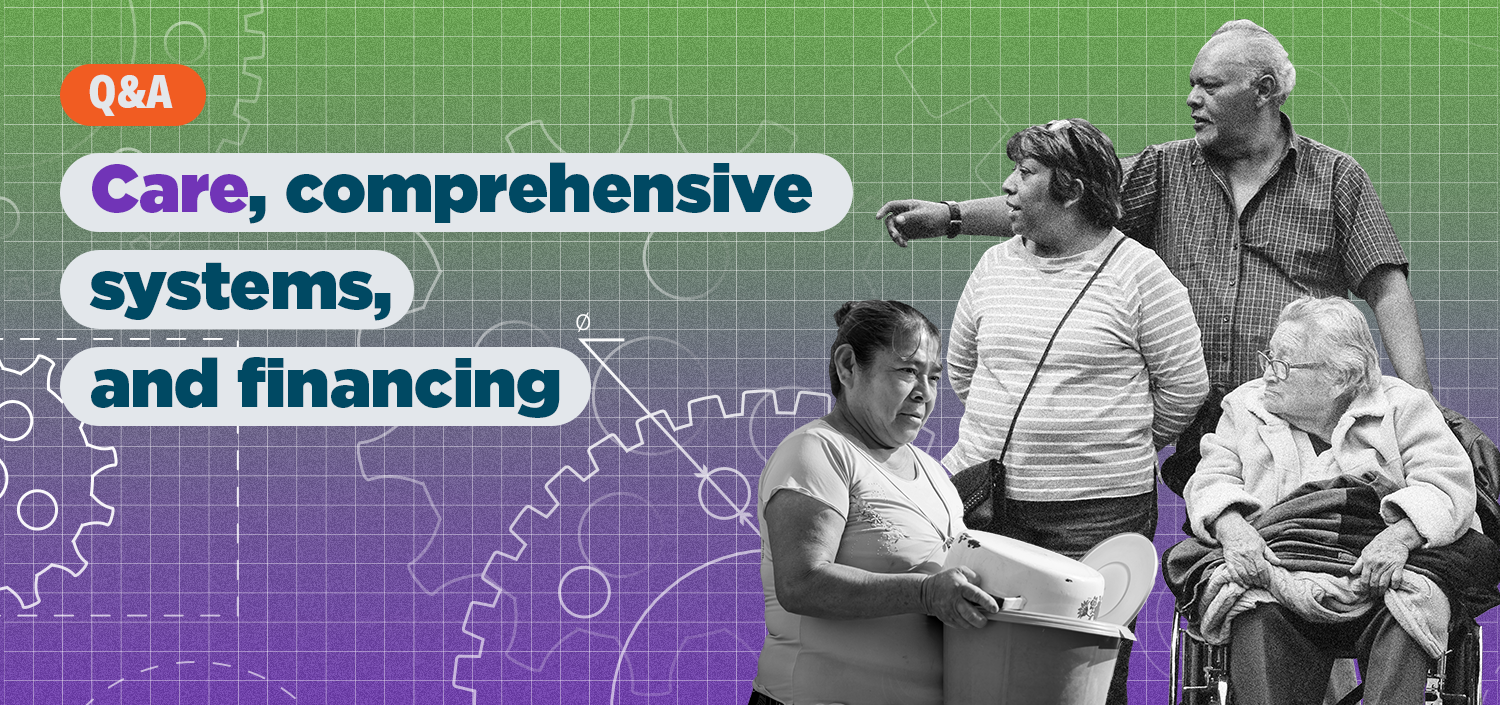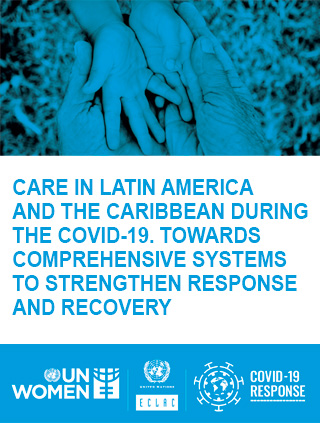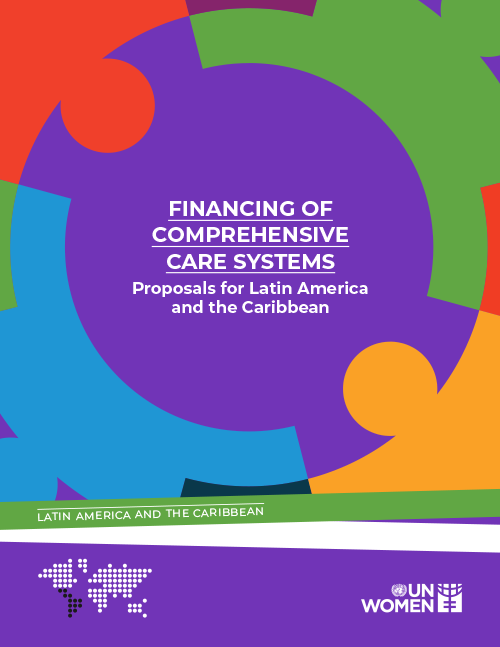Q&A: Care, comprehensive systems, and financing
Date:

To advance toward substantive equality and achieve sustainable development by 2030, it is necessary to overcome four structural challenges that constitute gender inequality in Latin America and the Caribbean. The challenges are 1) socioeconomic inequality and the persistence of poverty; 2) discriminatory and violent patriarchal cultural patterns and the prevailing culture of privilege; 3) the sexual division of labor and the inequitable social organization of care; and 4) the concentration of power and hierarchical relations in the public domain (ECLAC, 2017a).
These challenges reinforce each other and generate complex socioeconomic, cultural, and belief systems that hinder and reduce women's possibility of achieving autonomy.
The unfair and naturalized sexual division of labor has generated that caregiving tasks are mainly carried out by women in the home in an unpaid or paid manner, often precariously and informally.
This series of questions and answers are designed to explain the relevance of care for societies, the sustainability of life, and the current status of caregiving in our region.
Let's start with the first one:
What is care?
The term "care" refers to all activities that regenerate people's physical and emotional well-being on a daily and generational basis.
Care encompasses the daily tasks of managing and sustaining life, such as maintaining households, caring for family members, raising children, and self-care.
Who requires more care?
Care permeates through everyone's life. And all people, at all stages of life, require care.
Care is essential for all people in their daily lives. Depending on factors such as age, health condition, physical condition, or circumstances, people demand a different level of care and are more or less able to provide it to others. Thus, a person requires care to become autonomous during childhood, then probably in adulthood, he/she will have to take care of the new generations, and perhaps in old age, he/she will require care again. Therefore, in addition to accompanying the life cycle of individuals and being a key factor in personal development, care is also an essential component of the reproduction of society, as it enables life to be sustained and activities to function as a whole.
What is the link between poverty and care?
The unjust social organization of care disproportionately affects the most impoverished women. This inequality is particularly acute for lower-income women (Quintile 1), who are submerged by various mechanisms known as "Sticky Floors," who occupy informal economic activities or sectors of activity with inferior conditions, in short hours, or temporary jobs with lower incomes. These women dedicate an average of 45 hours per week to unpaid work compared to women in the "glass ceilings" (quintile 5). This term describes the scenario of those who are incorporated into the labor market but who are prevented from reaching the highest hierarchies, and who dedicate 33.13 hours per week.
This generates a vicious circle between care, poverty, inequality, and precariousness since those in the worst economic situation are less able to hire part of the care services in a remunerated manner in the market, having to perform this work themselves.
What is time poverty, and how does it impact women's lives?
The more care work is performed, the more difficulties are faced in overcoming economic poverty since time poverty restricts opportunities for insertion into the labor market, a dire situation for women who head single-parent households.
This situation generates inequalities and time poverty concerning men, causing women to lose opportunities to participate in the various aspects of public life and to develop their life projects.
As a consequence, women face more significant barriers to participating fully in paid work opportunities. Evidence indicates that the time dedicated to unpaid domestic and care work is the main obstacle to women's full participation in the labor market. According to ECLAC data, around 60% of women in households with children under 15 years of age state that they do not participate in the labor market due to household responsibilities, while in households with no children under 15 years of age, this figure is close to 18%i.
Likewise, to reconcile the assigned responsibilities of care with income generation, women have shown a more significant presence in part-time jobs and informal economic activities.
What are the consequences of inequality of care in society?
This inequality is structural and has consequences not only on the level of individual possibilities for women's economic autonomy and personal development but also on the functioning of society, which loses some of the talent and potential of women.
What is the care crisis?
In Latin America and the Caribbean, even before the COVID-19 pandemic, women spent three times as much time as men on unpaid care work. This situation is particularly acute for lower-income women (sticky floors), who spend an average of 45 hours per week on unpaid work, compared to women in the "glass ceilings," who spend 33 hours per week.
During the COVID-19 pandemic, the closure of schools and the reduction in the supply of services caused by the measures of confinement and social distancing to curb the crisis aggravated this inequality since it was women who gave up paid work to meet the growing demand for care. Women, therefore, experienced a severe deterioration in their living conditions. In this sense, ECLACii pointed out how the forceful exit of women from the labor market meant a setback of 18 years in terms of their labor participation.
The crisis demonstrated the unsustainability of the current social organization of care, intensifying existing economic and gender inequalities since it is the poorest women who bear the heaviest burden of care and whose care overload conditions, to a greater extent, their opportunities for economic empowerment and autonomy.
How many women are involved in domestic work in Latin America?
Between 11 and 18 million people are dedicated to domestic work in Latin America: 93% are women. This accounts for 10.5% and 14.3% of women's employment in the region.
77.5% of women employed in domestic work operate informally, and their income is equal to or less than 50% of the average employed persons. There is an evident devaluation of this type of work. It is urgent to promote changes in the patriarchal culture of our societies to make them genuine care societies.
How can we influence this reality?
In Latin America and the Caribbean, the centrality of care in public agendas has been progressively incorporated, in a heterogeneous manner, as a result of growing political commitments, as well as the work of women's movements and analyses from feminist economics. These contributions have focused on the need to reorganize and redistribute care work as a key to aspiring to more egalitarian and inclusive societies.
For over four decades, ECLAC Member States, meeting at the Regional Conference on Women in Latin America and the Caribbean, have agreed on the Regional Gender Agenda aimed at guaranteeing women's rights, advancing towards the achievement of their autonomy, and laying the foundations for building societies with equality. Within this framework, the governments have approved a series of agreements that are essential for designing and implementing care policies.
The principles of universality and progression in care services
The agreements for the design of care policies reaffirm the principle of universality and progression in access to quality care services, the importance of co-responsibility between men and women, as well as between the State, the labor market, communities, and households, and the importance of promoting the financial sustainability of public care policies aimed at achieving gender equality.
The Regional Conference on Women in Latin America and the Caribbean and Care
This year (2022), the XV Regional Conference on Women in Latin America and the Caribbean will take place in Buenos Aires, Argentina, from November 7 to 11. Its central theme is: "The care society as a horizon for a sustainable recovery with gender equality."
A change in the development style is needed, placing the care society and the sustainability of life at the center of policies.
What is a Care Society?
Talking about a Care Society implies a drastic change in the current social contract because, in households, care work is still carried out by women and girls. We must recognize care as a human right and put it at the center of policies.
What is the role of government in the care society?
It is time for governments to consider the impact care has on poverty and time poverty to understand that there will be no empowerment of women without this transformation, which is necessary to design sustainable, progressive and universal comprehensive care systems consciously.
Where did the call for recognition and redistribution of care work come from?
The feminist and women's movements first demanded this recognition and redistribution of this burden, a new social pact, and public policies that would make it visible and provide a solution.
Social and gender co-responsibility
Currently, in the region, care has ceased to be a women's issue or one that can be solved by itself and is seen as an issue that society must deal with for ethical, justice, and survival reasons. In line with these advances, several countries in the region have implemented programs, policies and even comprehensive systems to move towards the recognition, redistribution and reduction of care work at the national and local levels. And we dare say that a Latin American school of care has been consolidated, complementing European references to the cultural reality of Latin America.
Defining social co-responsibility as one of the guiding principles for the construction of care systems implies considering it as the result of the sum of efforts of all the actors in society who can be welfare providers: the State at central and decentralized levels (national/federal, provincial or municipal), the labor market, families and the community as a whole. For this reason, the principle of co-responsibility and intergenerational solidarity are key elements in considering the structures, models, and sources of financing of these systems, as will be seen below, based on solidarity from a socioeconomic and intergenerational point of view.
Why do we speak of care as a pillar of social protection?
All these collective efforts are part of a determined drive to move toward the Care Society. In this sense, investment in Integrated Care Systems as a fundamental pillar of social protection is a step towards guaranteeing rights and achieving gender equality, empowerment, and autonomy for women, as well as making a fundamental contribution in terms of well-being and boosting the economy. The welfare regimes or social protection systemsiii in our region, even with their own characteristics and unequal degrees of development in terms of coverage and quality of benefits, were built on the basis of three pillars: health, education and social security (UN Women and ECLAC, 2020). Today, in order to consolidate fairer and more inclusive societies, it is necessary to consolidate a social protection system, that is, to integrate a variety of actions aimed at guaranteeing minimum standards of living for all.
What do we mean by comprehensive care systems?
When we speak of comprehensive care systems, we refer to the set of policies aimed at implementing a new social organization aimed at caring for, assisting, and supporting people who require it, as well as recognizing, reducing, and redistributing the work of caregiving, which today is mainly performed by women, from a human rights, gender, intersectional and intercultural perspective.
These policies must be implemented based on inter-institutional coordination from a people-centered approach, where the State is the guarantor of access to the right to care, based on a model of social co-responsibility - with civil society, the private sector, and families - and gender co-responsibility - between men and women.
What principles guide the creation of comprehensive care systems?
In this sense, the creation of comprehensive care systems should be guided by the principles of care as a right, universality, co-responsibility, promotion of autonomy, and solidarity in financing.
Implementing a comprehensive care system implies intersectoral management that considers cultural and territorial diversity and allows for the gradual development of its components: services, regulations, training, information and knowledge management, and communication for the promotion of cultural change.
What is the link between comprehensive care systems and decent work?
Moving towards comprehensive systems of care is key to guaranteeing both the right to care for those who need it throughout life and the right of those who care, ensuring decent working conditions.
How are comprehensive care systems financed?
States play a crucial role in implementing comprehensive care systems, which is why they must guarantee resources for their financing through their budgets.
It is important to highlight the importance for Latin American and Caribbean countries to advance in the creation and strengthening of care systems from a systemic and comprehensive approach and, of course, with a gender perspective, incorporating all populations requiring care, generating synergies with economic, employment, health, education, and social protection policies, and promoting social co-responsibility between households, the State, the market and the community. This is the most strategic way to confront the economic and social consequences and impacts caused by the multiple crises that are affecting us and to rebuild with greater equality without leaving anyone behind.
The financing of care systems, like the rest of the pillars of social protection systems (education, health, and social security), requires a fiscal and social pact from which our societies can define welfare goals. Collective welfare is not possible without solidarity.
UN Women promotes the consolidation of sustainable, progressive, and universal comprehensive care systems to move toward the Care Society.
What are the benefits of investing in care?
Investing in care systems is not only necessary but also intelligent because this investment generates multiple benefits, among others:
-
It contributes to the comprehensive development and autonomy of girls and boys by improving their physical and cognitive development generating lasting effects in adulthood through employment and income prospects throughout their lives.
-
Improves the quality of life and autonomy of the elderly, people with disabilities, or in situations of dependency, which generates a more efficient use of investments in health systems.
-
It favors the economic autonomy of women since by reducing the burden of unpaid care work, they can increase their participation in the labor market. This participation increases families' income and disposable income, improving their savings and consumption capacity.
-
It enables the direct and indirect creation of quality employment. The ILO has estimated that investing in universal childcare and long-term care services could generate up to 280 million jobs by 2030 and another 19 million by 2035. It is estimated that women would fill 78% of these new jobs, and 84% would be formal employmentiv. Evidence shows that investment in care can generate up to three times more jobs than the same amount invested in the construction sectorv.
-
All of this makes investment in care a key driver of economic recovery.
-
In addition, part of this investment is recovered by governments through taxes and social security contributions as a result of the growth in quality employment and the increased earning capacity of families.
In short, investment in care makes it possible to break the vicious circle of care, poverty, inequality, and exclusion, transforming it into a virtuous circle that generates multiple social and economic returns.
References
[1] Panorama Social de América Latina
[3] Aquí se utilizarán indistintamente las denominaciones “régimen de bienestar” y “sistema de protección social” para denominar los sistemas de políticas sociales basados en tres pilares: los sistemas de salud, de educación y de seguridad social. Nótese que en otros casos la expresión “Sistema de Protección Social” alude al conjunto de políticas y programas sociales que tienen como personas destinatarias o beneficiarias a aquellas en situación de pobreza o vulnerabilidad social
[4] OIT (2022), Care at work: Investing in care leave and services for a more gender equal world of work
[5] De Henau, Jerome y Susan Himmelweit (2021), “A Care-Led Recovery from Covid-19: Investing in High-Quality Care to Stimulate and Rebalance the Economy.” Feminist Economics, vol. 27, N° 1–2, pág. 453–69


